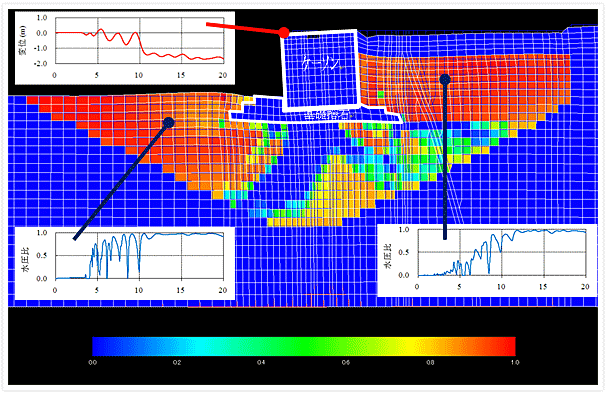This Page is Home![]() Technologies and Innovation
Technologies and Innovation![]() Civil Engineering Technology
Civil Engineering Technology![]() Evaluation of damage to structure due to Liquefaction by FLIPģ®
Evaluation of damage to structure due to Liquefaction by FLIPģ®
Evaluation of damage to structure due to Liquefaction by FLIPģ (Finite Element Analysis Program for Liquefaction Process)
Penta-Ocean provides assessment services to numerically evaluate the earthquake resisting capacity of port facilities, using the FLIP® system. FLIP® is an effective stress analysis method developed by the Japanese Port and Airport Research Institute, which evaluates residual displacements with consideration of the effect of liquefaction and dynamic interaction between structures and their foundations. Some case studies from the 1995 South Hyogo Prefecture Earthquake revealed that displacements predicted by numerical analysis using FLIP® proved to be very accurate. Owing to the prevalence of earthquakes in Japan, higher earthquake resisting capacity for port facilities is essential. More sophisticated evaluation methods make it possible to construct facilities with greater resistance to degradation or destruction from seismic related activity.
Liquefaction effects considered
FLIP® makes it possible to rationally assess residual displacements of structures and induced stress of structural elements, due to earthquake liquefaction, such as decreasing bearing capacity and changes of the amount and mode of soil pressure.
Rational antiseismic designs
Principle of performance based design introduced by the revision in Japanís Technical Standards for Port and Harbor Facilities, has increased design flexibility so that optimized and cost effective designs can be implemented, as long as design requirements can be satisfied. Although higher technical skills are demanded, an improvement in accuracy of analysis facilitates more rational antiseismic designs for construction.
Expanding the application of FLIP®
Seismic evaluations which take into account the effects of liquefaction are often required for piled or box-culvert structures in water-front area, and so the demand for the application of FLIP® in order to create more earthquake resistant designs for power generation plants is also on the rise.

An example of FLIPís analysis result for a caisson type quay wall
(contours and graphs of residual displacement and hydrostatic excess pressure)
